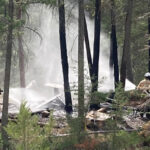Home »

Warmer temperatures prompt flooding reminders
With warmer conditions expected to settle in over the next few weeks, and a higher than normal snow pack, the Regional District of East Kootenay (RDEK) is reminding residents about the importance of being aware and prepared for the possibility of spring flooding.

The snow pack is currently sitting at about 135% of normal, and we haven’t yet hit our spring freshet.
“We know we are going to see that snow make its way into our rivers and streams over the next few weeks, but it’s important to understand that the level of the snow pack is less significant than the way the melting occurs. For example, if we have a stretch of warm days and cool nights, the melt will be completely different than if we go into a string of really hot days, warm nights and rain,” says RDEK Communications Manager, Loree Duczek. “Having said that, there are a number of things the public can do to help themselves and help us be prepared in the event flooding occurs, including: staying away from fast moving or high water, preparing their properties if they are in an area that typically experiences spring flooding, and reporting any unusual or rapidly changing conditions in rivers and streams.”
If people notice creeks or rivers become suddenly chocolate brown with large chunks of debris or if the flow suddenly decreases or stops, they should report it as soon as possible so the situation can be properly assessed by Provincial Flood Assessors.
Additionally, if people are experiencing flooding that is impacting their access or affecting large areas, it should be reported so local emergency program officials are notified.
The number to call in these situations is 1-800-663-3456. This is a provincial coordination centre and is the fastest way to get the best-coordinated local response.
The only time 9-1-1 should be used is if you feel your life or the lives of others are in danger.
The RDEK Emergency Programs have secured additional sandbags, are doing a regional inventory of supplies and resources, and are participating in regular updates with Emergency Management BC, the River Forecast Centre and Environment Canada. Emergency Program staff members have also completed Flood Observer Training. For information on the RDEK’s Emergency Programs, contact Melody Munro at 250-489-2791 or 1-888-478-7335.
“Living in a mountainous area that enjoys four full seasons, there is always a possibility of seasonal spring flooding as we transition from winter to summer. The best thing we can do to prepare is use common sense: be prepared, stay safe by staying away from rivers and streams and report flooding if you see it,” adds Duczek.
Emergency Management BC has extensive flood preparedness information on its website, including everything from packing an emergency kit to proper sandbagging techniques: www.embc.gov.bc.ca .
RDEK







